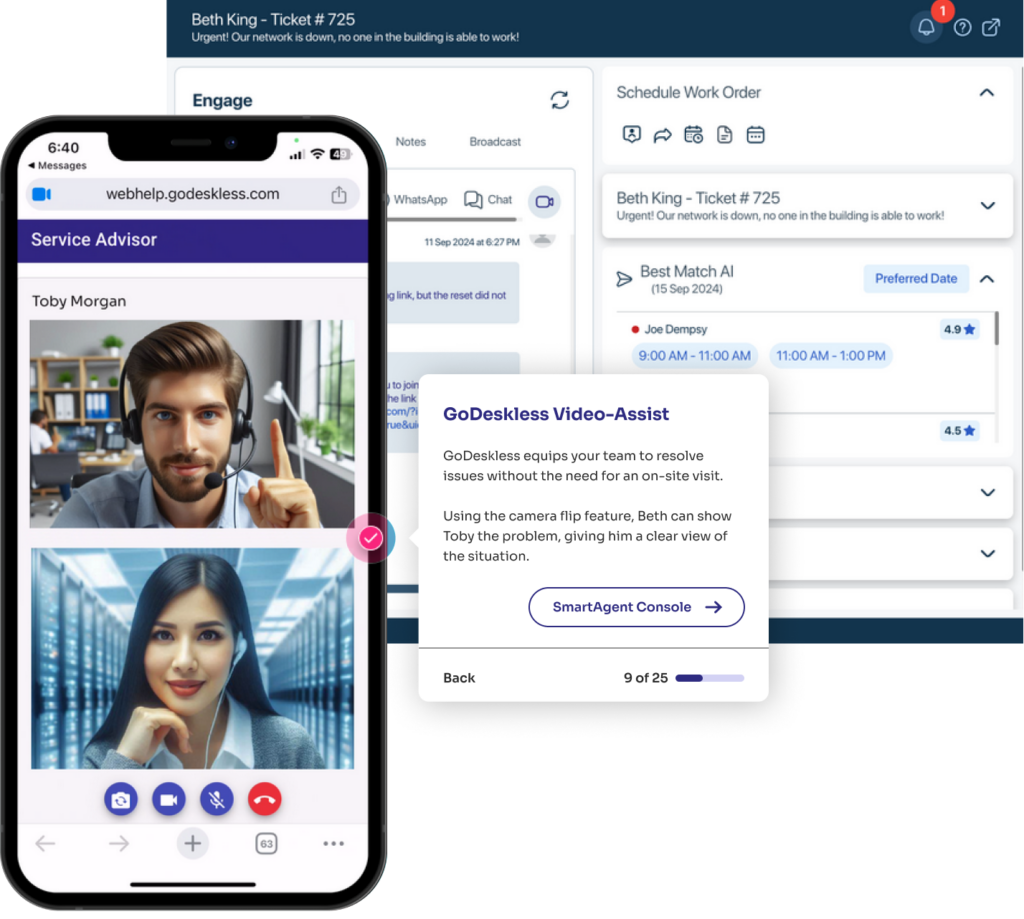Key Takeaways
- The non-desk field workforce comprises 80% of the global working population.
- Companies provide their deskless field workers with office-based communication and scheduling tools despite the mobile nature of these workers’ tasks.
- The use of office-based communication and scheduling solutions drive down employee productivity and efficiency.
- It’s also costly. Organizations are losing millions of dollars every year due to poor communication and rigid scheduling tools.
- The rising trend of remote work due to COVID-19 highlights the need for field service management technology and tools that are tailored to meet the needs of the deskless field workforce.
The Cost of Using the Wrong Tech
Investing in the wrong communication and scheduling tools can exact a heavy toll on any enterprise. Despite making up 80% of the global workforce, many deskless field workers are forced to use office-based software solutions, making them ill-equipped to perform at a high level of efficiency and productivity.
The sad reality is that only 39% of organizations equip their deskless workers with software that is fully tailored to meet their requirements. Moreover, only1% of technology and software development spending is allocated for deskless technology and tools.
In this highly digital age where deskless field workers are becoming increasingly vital, it’s crucial they receive technology and tools that are totally designed for their roles.
In an article by Microsoft, poor communications in the workplace cost companies $62.4 million every year. Miscommunication between employees, supervisors, and field teams drives down individual and collective efficiency and productivity, creates silos, and impedes collaboration.
Rigid scheduling systems and practices hamper employees’ productivity as well. Inefficient workforce scheduling can lead to increased absenteeism, lack of collaboration, poor retention of employees, and reduced profits among others.
In addition to a huge slide in efficiency, poor scheduling can also result in absenteeism, which can cost a company $3,600 per year for each hourly worker.
A Difficult Reality for Deskless Workers
The majority of the field workforce constantly face the challenges every single workday. Equipment operators, trailer drivers, field engineers, construction workers, and mechanics to mention some.

Tethered business software and applications require consistent and reliable internet connectivity. These also lack mobile-friendly capabilities and real-time functionalities, which are highly useful considering the mobile nature of the deskless workers’ profession.
85% of field workforce say that the communication they receive on the job is inadequate. The lack of mobile communication and productivity tools means deskless workers don’t have access to the people, knowledge, and resources that help them do their jobs and don’t have the passion and motivation to perform well or even meet minimum expectations.
The lack of proper communication tools also cause disruptions in deskless field workers’ personal lives. A study revealed that 88% are contacted by employers during their off hours. Another 64% say employees contact them through their personal devices.
Deskless Workers Need Flexible, Not Rigid, Scheduling Tools
Utilizing office-based scheduling tools means deskless workers are pressed to access a desktop computer constantly to be aware of their work schedule. However, the mobile nature of non-desk professionals limits access to a desktop.
Inability to see their schedules in real time can create confusion and lead to poor coordination. Deskless employees fail to understand when he or she is supposed to come in to work, or miss a shift because of a last-minute schedule change. When employees are forced to perform multiple tasks due to poor scheduling, their productivity slides down by 40%.
According to a study, 63% of the field workforce said they missed a significant social event or holiday. Another 36% reported missing a major life event. 59% of said workers also reported that they missed out on sleep, meals, and time for themselves.
Companies’ employee retention rate also suffers – 31% of deskless workers will leave their jobs if employers don’t give them their schedules in advance.
Change is Coming
The disruptions of COVID-19 and the growing trend of remote work effectively highlighted the need for field service management and other deskless technologies tailored exactly for deskless employees. This growing awareness has pushed essential business sectors such as construction, manufacturing, and healthcare to increase their budget for deskless tech development.
Expectations are already mounting. According to a survey, 61% of companies with plans to invest more in deskless technology and tools expect to see a boost in productivity. 52% want to achieve better communication while 51% anticipate enhanced employee experience.
However, 39% of employees say that while their employers invest in a lot of technology, it isn’t the right technology to help them do their jobs. Purchasing of deskless technology is mostly a top management exercise. 51% of technology investments are decided by the C-suite and 38% by mid-level managers. Deskless field workers only have an 11% participation.
This must change. Business leaders need to realize that people on the ground have a firmer grasp on the field service management technology they need to become more efficient, reliable, and valuable assets to the organization.





